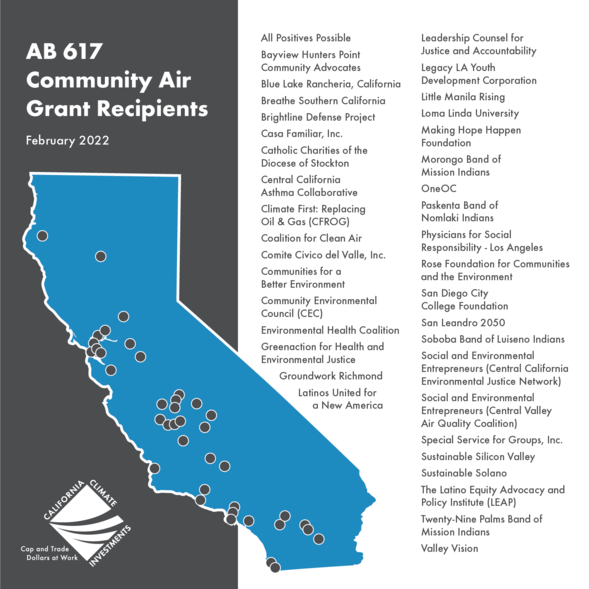|
SACRAMENTO – The California Air Resources Board (CARB) awarded $10 million in grants to help 33 community organizations and five Native American Tribes reduce air pollution in their neighborhoods.
The Community Air Grants were awarded to communities across California that face significant challenges with air pollution including the Inland Empire/Border region, the Central Valley, Los Angeles, the Bay Area and San Diego.
The Community Air Grants Program is part of CARB’s overall efforts to implement Assembly Bill 617. Community Air Grants are designed to establish a community-focused approach to improving air quality and reducing exposure to toxic air pollutants at the neighborhood level. AB 617 is unique in that it requires CARB and air districts to work with residents, businesses and other stakeholders to tackle air pollution at the community scale. The current grants elevate community voices and their specific priorities regarding air pollution where they live. As a result, the projects funded will help communities identify areas with the most harmful air emissions and then take actions to reduce exposure or address the underlying cause of the pollution.
“The Community Air Grants provided by CARB are an important tool to help residents and Tribal communities throughout the state identify and combat the harmful effects of local air pollution -- and create a cleaner environment for their families,” said CARB Chair Liane Randolph.
“These grants continue to build on the model of AB 617—creating opportunities for CARB to support the work of communities to develop local solutions to address and reduce a variety of sources of air pollution in the communities,” said Chanell Fletcher, CARB Deputy Executive Officer of Environmental Justice. “These funds provide a much-needed resource for communities to clean the air residents and their children breathe.”
“I am pleased to see California focus funding to support our most environmentally vulnerable communities and Tribes on the front lines of the climate crisis. These grants will help fulfill the goals of AB 617 by empowering diverse neighborhoods across our state with the tools to combat their own unique air pollution concerns and significantly improve their local public health outlook,” said CARB Board Member, Assemblymember and AB 617 joint author Eduardo Garcia.
The selected projects reflect the diverse needs across the state and include community-driven air monitoring, improving public access to information about local pollution sources, reducing community exposure and tracking progress on pollution reduction efforts. Examples of selected projects include:
Southern California
Breathe Southern California (Breathe SoCal) will pilot an accountability-focused Freight Sustainability Score for major retailers who move cargo via the San Pedro Bay Port Complex in an effort to improve public health and environmental justice, primarily in disadvantaged communities.
OneOC and its collaborators will build on their air monitoring pilot project of the industrial corridor in Santa Ana and expand monitoring to include more sources of air pollution, which have been identified by residents. These sources include truck traffic, fireworks and noise pollution.
Northern California
The Paskenta Band of Nomlaki Indians proposes to develop an air monitoring network for the Tribal community to raise awareness of air quality issues stemming from wildfire and other pollution sources.
Blue Lake Rancheria will establish a community PM air monitoring network and include educational materials about PM air quality in general and during woodsmoke and wildland fire events, along with conducting extensive capacity building.
Central Valley
Catholic Charities of the Diocese of Stockton and Little Manila Rising are working in collaboration to implement a community engagement strategy that supports Stockton’s AB 617 Community Emissions Reduction Plan (CERP).
Central California Asthma Collaborative continues the work of maintaining, expanding and enhancing the SJV Community Air Monitoring Network (SJVAir). This includes data collection, analysis, display and automated text notification of real-time data from calibrated PM2.5 monitors (Purple Air) installed in disadvantaged communities across the San Joaquin Valley.
Inland Empire/Border Region
Comité Cívico del Valle (CCV) aims to continue the community monitoring efforts in the Salton Sea Air Basin, a region that encompasses the Imperial and Eastern Coachella valleys.
Casa Familiar plans to sustain the community-based air monitoring system in the U.S.-Mexico border town of San Ysidro that has been in place since 2017. Concerns in this border town include location next to the busiest land Port of Entry in the Northern Hemisphere, freeways bounding the community, freight trains and pollution transported from Mexico.

The Community Air Grants Program is part of California Climate Investments, a statewide initiative that puts billions of cap-and-trade dollars to work, particularly in disadvantaged communities.
The Board will hear an informational update on Community Air Grants in the morning on Friday, February 25, at its regular meeting.
Additional Resources
CARB is the lead agency in California for cleaning up the air and fighting climate change to attain and maintain health-based air quality standards. Its mission is to promote and protect public health, welfare, and ecological resources through the effective reduction of air and climate pollutants while recognizing and considering effects on the economy.
|